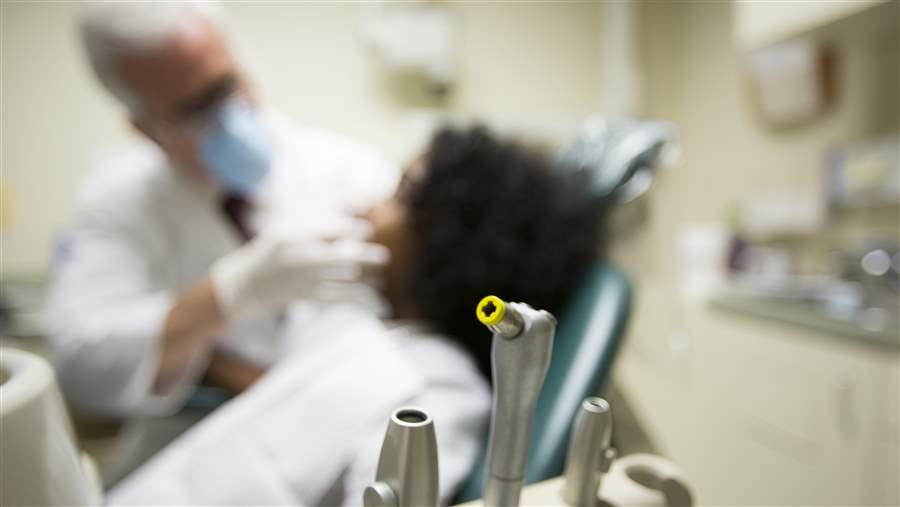These Dental Health Solutions Could Help Millions of Americans
Dental therapy and school-based sealants can expand access to care and prevent oral disease
 © The Pew Charitable Trusts
© The Pew Charitable TrustsThe death in 2007 of Deamonte Driver, a 12-year-old who succumbed to a tooth abscess that spread to his brain because he could not get timely dental care, inspired The Pew Charitable Trusts to begin working the next year to improve access to the prevention and treatment of dental disease. Pew’s early efforts focused on children; since then, growing evidence has pointed to the dire oral health and access problems of working-age adults, individuals with disabilities, and senior citizens.
Today, Pew’s dental campaign aims—through research and advocacy—to bridge gaps in dental health access for people of all ages by increasing the number of states authorizing dental therapists and expanding the use of school-based sealant programs. Strong evidence shows that these approaches effectively address both ends of the dental health spectrum by preventing disease before it starts while also creating more avenues for patients to seek routine care.
Dental therapy
Dental therapists are similar to physician assistants in medicine and provide preventive and routine restorative care, such as filling cavities. Enabling dentists to expand their teams to incorporate these midlevel providers has helped to improve access to care in 54 countries and, more recently and closer to home, in Minnesota and with Native American tribes in Alaska and Washington state. Dental therapists will also work soon in Maine and Vermont, which passed laws authorizing them to practice in 2014 and 2016, respectively, and in Oregon, which recently approved a pilot program allowing two local tribes to hire these specialists.
In a number of other states—including Massachusetts, Michigan, and North Dakota—Pew is working closely with dental organizations, legislators, providers, and other oral health stakeholders to support efforts to allow dentists to hire dental therapists. Support for this common-sense model spans the political spectrum and unites partners committed to increasing access to oral health care.1 Dental organizations such as the American Association of Public Health Dentistry also support this model of care.2
School-based sealant programs
Some of Pew’s earlier advocacy work focused on removing state policies, known as prior exam rules, that required dentists to conduct a dental exam before a hygienist could apply a sealant. Significant strides were made in eliminating those rules, which are costly and inhibit the effectiveness and reach of school-based sealant programs. Since 2012, nine states eliminated their prior exam rules, bringing the number of states without them to 40. School-based programs that serve low-income children have been found to reduce decay rates by an average of 60 percent over five years; however, our 2014 50-state sealant report concluded that while most states operated school-based sealant programs, 39 states and the District of Columbia lacked sealants in most of their high-need schools.
That report was one of 27 research products that Pew has published since 2008 on a variety of dental health policy issues. Topping our current research agenda is an investigation of the policy and regulatory barriers that impede the growth of sealant programs in schools serving concentrated numbers of low-income children. This latest round of research was inspired by an open-ended question on the Association of State and Territorial Dental Directors’ 2013 membership survey on sealant policies, which asked about other obstacles that may be blocking the growth of sealant programs. We will be investigating Medicaid payment and managed care policies, as well as rules specific to federally qualified health centers that may be preventing the growth of such programs.
Pew believes the strategies we support could make a difference to the millions of children who currently receive no preventive care and the millions of children and adults who are left out of the dental care delivery system. Improving access to both prevention and treatment will require a shift in the way care is delivered, the types of providers who offer it, and the locations where patients can seek it. Much work remains to achieve needed reforms.
Jane Koppelman is research director for The Pew Charitable Trusts’ dental campaign.
Endnotes
- National Black Caucus of State Legislators, “Expanding Access to Oral Health Care,” Health and Human Services Resolution HHS-15-24 (December 2014), http://nbcsl.org/public-policy/resolutions/item/download/ 498_a4ef9a2aa5c706f05d26255b6dfbdb96.html; National Foundation for Women Legislators, “Resolution: In Support of Calling Upon the United States Congress to Provide Full Funding for the Alternative Oral Health Workforce Providers Demonstration Grant Program” (2014), http://www.womenlegislators.org/wp-content/uploads/2016/02/nfwl-dentalworkforceresolutionforwebsite.pdf; and Wendell Potter, “Why I’m OK Having a Mid-Level Dental Practitioner Work on My Teeth,” the Huffington Post (April 21, 2015), http://www.huffingtonpost.com/wendell-potter/why-im-ok-having-a-mid-le_b_6607158.html.
- American Association of Public Health Dentistry, “AAPHD Publishes Proposed Curriculum Guidelines for Training Dental Therapists,” (June 2011) http://www.aaphd.org/aaphd-publishes-proposed-curriculum-guidelines.







